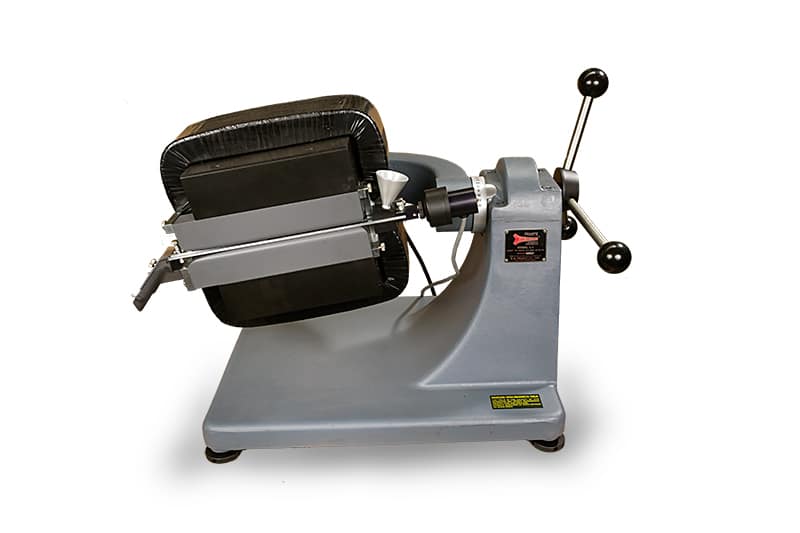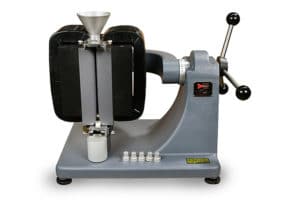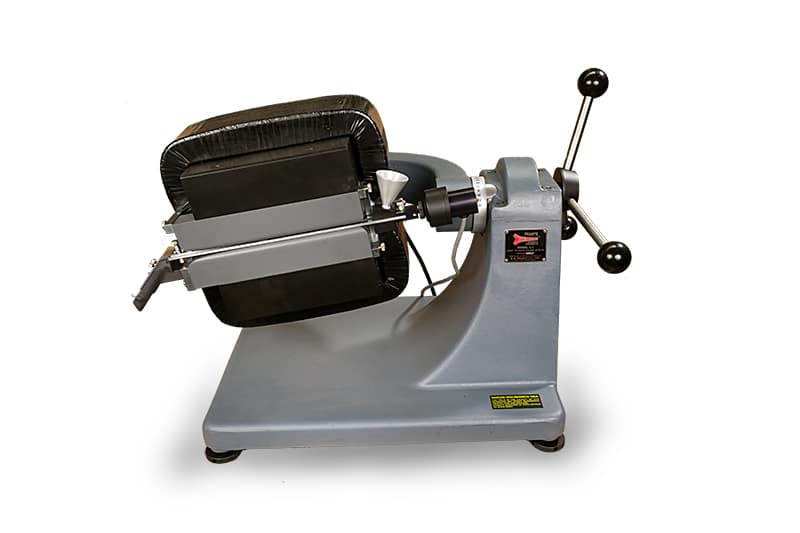Our Isodynamic® Laboratory Separators make sensitive separations of minerals or other grains according to magnetic susceptibility, even of materials not usually thought of as magnetic. Magnetic force per unit volume on particles of like susceptibility is constant across the width of the operating space at the midplane between the pole faces, where separation is affected. Since it urges particles in directions parallel to the midplane, their responses are unaffected by their positions in the operating space.
Power is supplied to the magnet coils of the separator by a regulated power supply (which provides linked regulation of direct current and voltage). Current can be adjusted from zero to over 2 amperes at start-up. The power supply will maintain 1.8 amperes indefinitely at ambient temperatures up to approximately 32ºC (90ºF). At 1.8 amperes, the magnetic field strength in the narrowest part of the gap is approximately 20 kilogauss.
HOW THE L-1 ISODYNAMIC® LABORATORY SEPARATOR WORKS
- Material is fed into one end of the magnetic field of an electromagnet having two long pole pieces shaped to a special contour (with a long narrow air gap between them).
- The material travels the entire length of the pole pieces, with the more strongly paramagnetic particles being urged toward the narrow side of the gap.
- The grains are intercepted by a dividing edge which directs the two fractions into separate containers.
NOTE: The magnetic system is carried on a universal mounting so it can be oriented in any direction with respect to gravity (see below).
The inclined chute mode of operation.
Separations by the inclined chute mode of processing are made at relatively slow feed rates. The orientation of the magnetic system and the chute is adjusted to establish the desired relationship between magnetic and gravitational force and to provide conditions consistent with the movement of the materials through the field. Two engraved scales, one at each end of the arm supporting the magnetic system, indicate orientation.
Particles traveling down the chute take paths determined by their magnetic susceptibilities: the direction of motion of each particle is substantially the result of the magnetic and gravitational forces upon it in the plane of the chute. Over the relatively long distance that each particle travels in the field, the constant ratio of magnetic to gravitational force to which it is subject tends to correct deflections resulting from chance collisions.
A feed hopper is screwed into a solid plastic socket at the upper end of the chute, with its orifice near the chute floor at an adjustable height that permits the discharge of material at a controlled rate when vibration is supplied. A splitting ridge divides the lower part of the chute into two channels which guide the separated fractions out of the field into separate containers.
The vertical feed mode of operation.
Operated in the vertical feed (or free fall) mode, the Isodynamic® Separator is suitable for separating free-flowing sands in the range of 30 to 100 mesh. Heavy sands can be fed at rates up to 20 lbs. per hour. Rapid separations are possible, although repeated passes are usually necessary to obtain good separations. The positions of the feed and divider assemblies are independently adjustable by rack and pinion with engraved scales. Settings are reproducible. Interchangeable bushings, with openings of 3.2, 3.6, 4.0, 4.4, and 4.8 mm, which fit into the bottom of the large feed hopper, provide a range of feed rates.
TYPICAL ISODYNAMIC® LABORATORY SEPARATOR APPLICATIONS
Our L-1 Isodynamic® Laboratory Separators are commonly used in:
- Geologists/Mineralogists – for separation to classify samples according to magnetic susceptibility (which usually corresponds to specific minerals or mineral compositions)
- Quality Assurance Laboratories – for separation to qualify the composition of materials
- Material Processing – for separation to verify ferromagnetic properties and assure product uniformity (when used in conjunction with the LFC-3)
L-1 ISODYNAMIC® LABORATORY SEPARATOR SPECIFICATIONS
S.G. Frantz L-1 Isodynamic® Laboratory Separators have proven to be extraordinarily reliable over a period of more than 50 years. In fact, the first unit produced is still in use today. If you are in need of a dependable Isodynamic® Laboratory Separator, contact S.G. Frantz.
ISODYNAMIC®LABORATORY SEPARATOR SPECIFICATIONS
| Height | Width | Depth | Current @ 150V DC | Net Weight | Shipping Weight | |
|---|---|---|---|---|---|---|
| Model No. | Inches Centimeters | Amps | Pounds Kilograms |
|||
| L-1 | 21 54 | 30 76 | 16 41 | 2.5 | 329 150 | 550 250 |
Contact us today to learn more about S.G. Frantz or any of our Electromagnetic, Permanent Magnet, and/or Laboratory Separators.



